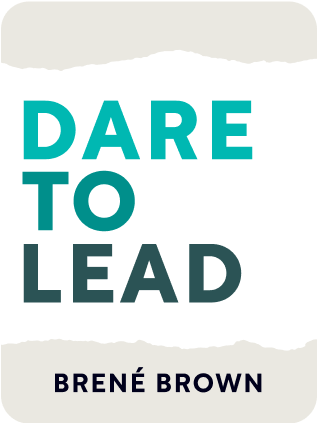

This article is an excerpt from the Shortform book guide to "Dare to Lead" by Brené Brown. Shortform has the world's best summaries and analyses of books you should be reading.
Like this article? Sign up for a free trial here .
What is Brené Brown’s Dare to Lead about? What are the four skills needed for brave leadership?
Brené Brown’s Dare to Lead is the bible for brave leadership. The book seeks to get leaders to approach fear and uncertainty head-on, and to teach their subordinates to do the same. Brave leadership requires four skills and they are; facing vulnerability with courage, practicing your values, trust-building, and failure resilience.
Below is a brief overview of the key takeaways.
Dare to Lead: Brave Work. Tough Conversations. Whole Hearts.
Many work cultures are characterized by self-interested and self-protecting behaviors such as unmitigated criticism, avoidance of tough conversations, perfectionism, and the refusal to take risks. These behaviors stifle a work culture’s creativity and learning, and they’re toxic to the potential for innovation. The fear of failure and shame in uncertain situations causes team members to keep new ideas to themselves and avoid taking risks, which will hold your organization back in our world that constantly demands more creativity and innovation.
The Dare to Lead book prescribes brave leadership as the antidote to these stifled work cultures. Brave leaders approach fear and uncertainty head-on, and they teach their teams how to do the same. The Dare to Lead book explores four courage-building skills that will help you become a brave leader: facing vulnerability, choosing and practicing values, building trust, and developing failure resilience.
Skill #1: Face Vulnerability
Vulnerability is exposure to the risk of failure or emotional harm—facing vulnerability, the first skill of brave leadership, is meeting this exposure head-on and learning to master your response to the fear and uncertainty that come along with it. According to Brene Brown in the Dare to Lead book, mastering your response to vulnerability is vital when building an innovative, creative work culture because it’s impossible to have innovation and creation without failure and risk—in these cultures, choosing to avoid your vulnerability will result in defensive, self-interested behaviors catching up with you and holding you back.
Why We Avoid Vulnerability
Many people avoid vulnerability because they don’t quite understand what it really is—it’s important to clear up a few misconceptions about vulnerability before diving into the work of engaging with it.
The following misconceptions were identified in the Dare to Lead book:
Misconception #1: Vulnerability is weakness. People often refuse to acknowledge their vulnerable feelings, thinking doing so is brave. In fact, it signals that they’re not brave enough to engage with their vulnerability. If you’re feeling vulnerable, it’s because you were courageous enough to approach, not avoid, exposure to risk and uncertainty.
Misconception #2: You have to trust someone in order to be vulnerable with them. Neither comes before the other: vulnerability and trust happen in a constant exchange of small moments. When someone reaches out to you and you choose to engage with and respond to their vulnerability (instead of ignoring it), you earn their trust and the right to be vulnerable with them in turn.
Misconception #3: Vulnerability means full disclosure. You don’t need to spill everything to be vulnerable— the Dare to Lead book emphasizes that brave leaders practice vulnerability with boundaries and don’t overshare personal feelings or information with their team. Instead, they talk openly about the emotions surrounding uncertain or risky situations, like a new product launch or large systemic changes. Then, they ask for their team members’ questions or concerns, and they take the time to listen and engage—creating a safe space for their team members to sort through their feelings.
The Benefits of Facing Vulnerability
If you’re able to allow and productively engage with vulnerability in your work—and teach your team members the value of doing so—you’ll reap a number of benefits: honesty in tough conversations; fewer defensive behaviors; and the ability to understand and overcome feelings of shame.
Benefit #1: Facing Vulnerability Helps You Have Tough Conversations
Leadership comes with tough conversations that have uncertain outcomes, or demand emotional exposure from either party. Vulnerability allows you to approach these conversations with the courage to be honest and a guiding principle: it’s kind to be clear, and it’s unkind to be unclear. Not saying what you mean in these conversations prevents honest and productive connections—nevertheless, it’s tempting to default to unclear language, because it offers protection in several ways.
The Dare to Lead book lists two ways people instinctively avoid vulnerability in tough conversations:
Firstly, people often choose to be polite rather than honest, telling themselves this is the nice thing to do—but it’s just a way to avoid vulnerability. Honesty in the conversation might stir up discomfort or negative emotions, so you choose the predictable outcome of a polite half-truth. This behavior is especially damaging in feedback sessions. Polite, dishonest feedback is unfair—the recipient receives no indication that they need to improve, yet they’re held accountable for their lack of improvement.
Secondly, people often avoid talking about their true emotions, instead naming “easy” but inaccurate emotions—this allows them to talk about their feelings without full emotional exposure. This may be easier and more comfortable, but you can’t connect to or solve the root of people’s emotions if you don’t know what they are. In conversations about difficult emotions, you need to focus on clarity of language, which helps you best serve and connect with your team members.
A great example of pinpointing true emotions is Dede Halfhill of the Air Force. She found that her airmen were frequently complaining about being “tired.” She suggested that what they were truly feeling was loneliness, and they realized that this pinpointed their emotions exactly. Knowing this, she was able to better respond to their needs and focus on connection and inclusivity instead of giving leave, which further isolated them.
Benefit #2: Facing Vulnerability Discourages Defensive Behaviors
Some organizations try to remove vulnerability and emotions from their work culture to make team members more efficient and less susceptible to emotion. However, according to Brene Brown in the Dare to Lead book, this usually has the opposite effect. Refusing to face vulnerability allows your ego to react directly to failure or risk, resulting in defensive, ego-protecting behaviors such as:
- Perfectionism in order to avoid the shame and embarrassment of making a mistake
- Criticism and cynicism to shift negative attention and shame onto someone else
- Refusal to take accountability for mistakes in order to avoid the shame of having failed
- Weaponization of fear and power by leaders in an attempt to eliminate any chance of mistakes or failure
Brave leaders combat these behaviors by creating work cultures where team members are comfortable facing vulnerability and understand that risk and failure are tolerated and useful. The Dare to Lead book outlines three steps that leaders can take to diminish the defensive behaviors of their teams:
- Stop rewarding defensive behaviors. It’s easy to recognize when you’re doing this consciously, like when you commend a team member for never making a mistake. Be careful of when you’re doing it unconsciously, such as when you allow someone to criticize without following up with their own idea.
- Open up honest conversations with team members acting defensively. Remember to focus on your clarity of language to clearly name the behavior, question the emotional source of it, and suggest how they can improve.
- Recognize team members who commit to self-improvement. Use their healthy methods of improvement—such as asking questions and asking for help, balancing criticism with contributions, and taking responsibility for their mistakes—as an example for other team members to follow.
Benefit #3: Facing Vulnerability Helps You Understand and Overcome Shame
The goal of defensive behaviors is usually to avoid the particularly painful emotion of shame—the feeling that something you’ve done (or not done), a goal you haven’t achieved, or an ideal you didn’t measure up to makes you a flawed person who’s not worthy of connection or belonging.
However, it’s possible to overcome shame in a healthy way, without resorting to defensive behaviors. Shame loses its power when it’s discussed and met with empathy and support. Empathy is critical in innovative cultures because people are more willing to take risks if they know that they will be supported if they struggle or fail.
When meeting your team members’ shame with empathy, it’s important to understand that empathy is not simply making things better. Rather, it’s a connection with the emotions tied to someone’s struggle or failure. To practice effective empathy, focus on being nonjudgmental, understanding the emotions of the other person, and opening up the opportunity to talk about the feelings surrounding the experience. For example, after a team member has a tough presentation, you can respond with empathy by saying, “I’m really sorry for how that presentation went. I know it can be embarrassing. Do you want to talk about it?”
As a leader, you can combat behavior-driving shame in the workplace by talking to your team members through their struggles and failures, and encouraging them to express their emotions. Not only will this demonstrate to team members how they can practice empathy among themselves, but team members will also feel more comfortable taking risks knowing that you, and their colleagues, have their back.
Skill #2: Choose and Practice Your Values
The second skill of brave leadership explored in Dare to Lead is choosing and practicing your values. Having clear values and putting them into practice is essential to your team’s ability to make tough decisions and take risks—strong values push you to do what is right, rather than what is easy.
Your organization should have no more than two core values—if you have too many values, they become meaningless feel-good words that are too nebulous to be actionable. Imagine: “At X Corporation, we care about quality, collaboration, sustainability, knowledge, balance, and community.” These are all worthy values, but there are so many, it’s hard to know which one should be driving behaviors and major decisions. Your organization should have two evident values that team members can depend on when it comes to tough decisions.
To firmly establish these values in your organization, translate them into behaviors that can be taught, practiced, and evaluated. These behaviors provide clear guidelines of how you expect your team members to work together, make decisions, and show up to their work. Take the X Corporation example from above—let’s say that they decide on balance and knowledge as their two core values. Their balance value might translate into a “no work emails on the weekend” policy, and their knowledge value might translate to an expectation that everyone comes to the weekly marketing meeting with a question or a new tool or skill to share.
Strong values are especially important to giving and receiving feedback—a vulnerable process that often prompts defensive behaviors. While giving feedback, focusing on your values can help you approach the conversation in alignment with them. For example, having the core value of courage can push you to be honest and respectful, rather than dishonest and polite, while your core value of teamwork pushes you to work together with your feedback recipient to come up with solutions.
While receiving feedback, focusing on your values can help you channel your emotions productively, toward insight and learning, rather than defensively. You can do this by entering the conversation with a value-supporting mantra or behavior, such as “I have the courage to at least sit here and listen” (courage), “Paying attention will make me a better teammate” (teamwork), or “I will ask questions and fully understand” (curiosity).
Leading With Grounded Confidence: Practicing Values, Curiosity, and Self-Awareness
When faced with vulnerable moments or tough decisions, brave leaders depend on “grounded confidence”—confidence rooted in strong values, self-awareness, and curiosity—for the courage to face their vulnerability instead of hiding behind defensive behaviors. Dare to Lead identifies two components to developing grounded confidence.
The first component is continually practicing your values and self-awareness. This ensures that you will respond to pressure or tough situations with integrity, instead of reacting defensively. By their uncertain and risky nature, these moments of vulnerability will never be easy, but well-practiced values and self-awareness give you the confidence to face them, knowing fully that you’ll make it to the other side.
The second component is approaching your work with curiosity—that is, wondering what might happen instead of panicking about an uncertain outcome. With this approach, you take the time to examine problems and possible solutions, instead of racing for an answer and missing valuable learning opportunities.
Skill #3: Build Trust and Connection
The third skill of brave leadership is building trust and connection. Trust is essential to organizations—it allows people to feel comfortable trying new ideas or breaking the status quo, to rely on others, and to feel that others have their best interests in mind. Though we usually trust ourselves completely, we often have a hard time trusting others. However, we don’t talk about these trust issues for fear that doing so will cause a negative emotional reaction.
Brave leaders don’t shy away from these conversations, but they reframe the discussion of trust as a less emotional discussion of trustworthy behaviors. Instead of saying, “I don’t trust you with this project,” brave leaders say, “I want to discuss some reliability issues when it comes to meeting deadlines.” The concept of trust, once translated into behaviors, can be modeled, taught, and evaluated.
Keep in mind that trustworthy behaviors are usually found in small, everyday moments—not grand gestures. You can build trust in your team members, and their trust in you, by recognizing and practicing small trustworthy behaviors: setting and respecting boundaries, being reliable, taking responsibility for actions and mistakes, keeping confidence, and being generous with interpretations of others’ intent
Being generous with interpretations of others’ intent is especially important to practice, as it can reveal how your leadership might be causing untrustworthy behaviors. When someone falls short on a task, it’s easy to assume negative intent—that they don’t care, or aren’t committed. Assuming positive intent, however—assuming they were trying their best, but something got in the way—highlights where you may have given unclear guidelines, asked a team member to do something beyond their authority, and so on. This realization should prompt changes on your end, such as clearer guidelines, attempts to fill in knowledge gaps, or revised expectations to match your team member’s skills, authority, and knowledge. These changes give you the chance to rebuild your trust in your team member’s abilities, while they find that they can trust you not to give them tasks that they can’t accomplish.
Skill #4: Develop Failure Resilience
The final skill of brave leadership explored in Dare to Lead is developing your team’s failure resilience—the ability to recover and move on quickly after something goes wrong. This is an essential skill for leaders to teach, because people are more likely to take risks and try new ideas if they’re confident that they can recover from any setback.
Smart leaders teach failure resilience from the very beginning of the onboarding process, in order to normalize failure and demonstrate that team members will be supported, not shamed, when (not if) it happens. Otherwise, you’ll waste time fixing problematic behaviors that arise from the fear of failure, such as perfectionism, shifting blame, or team members covering up their mistakes.
Failure resilience has two main components: recognizing your emotional response to failure, and working through the story you create about failure.
Step 1: Recognize Your Emotional Response
You don’t need to know exactly what you’re feeling in response to a failure or setback, but you need to acknowledge that your emotions were triggered in some way. Instead of letting your ego take control, leaping directly from feeling to defensive behavior, this step lets you take the more productive route from feeling to thinking.
Step 2: Work Through the Story You’re Making Up
When you encounter failure, you naturally create a story to explain what happened and why. This “bad first draft,” based on incomplete information and insecurity, builds illogical connections and patterns to make a complete story. For example, you present an idea in a meeting and your colleague Anne glances at another colleague before rejecting your idea. The story you might come up with is, “Anne looked at Cheryl before saying no, and I bet that’s because they’ve been talking about me and think my ideas are stupid and not worth their time.”
To work through the story productively, you need to question its different components to separate facts from assumptions and insecurities. Ask yourself: What do I actually know about the situation? What am I assuming about the other people in the situation? What feelings are driving my reaction?
Then, talk through your story aloud. The phrase, “The story I’m telling myself…” is especially useful in these conversations—it lets you express your feelings, and invite the other person to share their side of the story. For example, you could say to your colleague, “When I brought up that idea, you looked at Cheryl before you said no. The story I’m telling myself is that you two have been discussing my ideas outside the meeting and don’t think they’re worth your time.” Approaching the story this way either shows you the false connections your story made, or opens up an honest conversation about her thoughts.
It’s especially important to lead your team in questioning and talking through “bad first drafts” in times of change or uncertainty in your organization, when rumors are prevalent. People tend to believe their stories and retell them as truth, breeding insecurity and anxiety. Just think how easy it is for “There will probably be massive layoffs at the end of the summer, I can feel it” to become twisted into, “There will be massive layoffs in August.”
You can stop these stories by offering as much information about the situation as possible, and speaking to your team with transparency to separate fact from imagination. This process of untangling bad first drafts will take some extra time, but keep in mind that spending some time addressing your team’s stories now will save you from wasting your time on fixing defensive behaviors down the road.
What the Four Courage Skills Give Us
Leaning into all four courage-building skills gives you control over how difficult situations affect you and your team members—you approach uncertainty, vulnerable emotions, and failure productively, instead of reacting to them defensively. Brave leaders who use and teach these skills are the leaders who can create work cultures capable of keeping up with the innovative and creative demands of our current world.

———End of Preview———
Like what you just read? Read the rest of the world's best book summary and analysis of Brené Brown's "Dare to Lead" at Shortform .
Here's what you'll find in our full Dare to Lead summary :
- A breakdown of the four courage-building skills that make up brave leadership
- The three reasons why most people avoid vulnerability
- How to recover and move on quickly from failure






